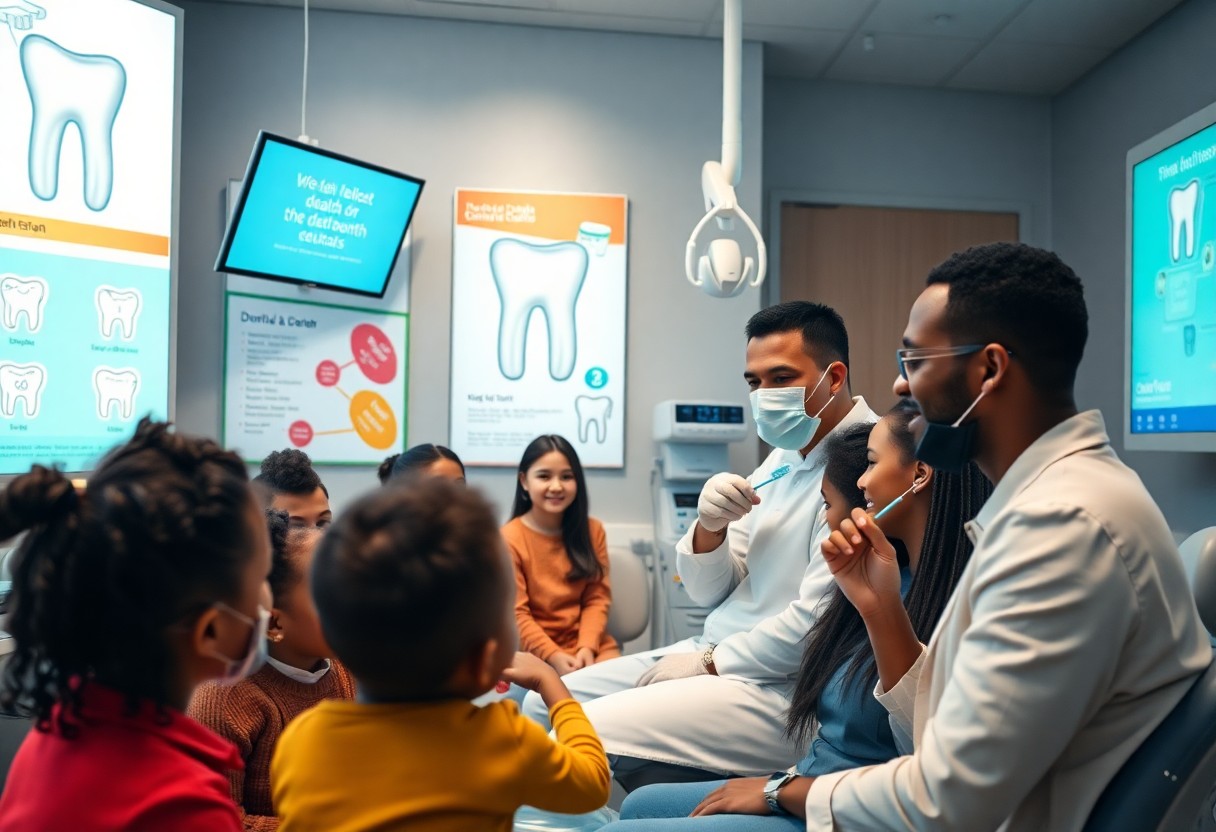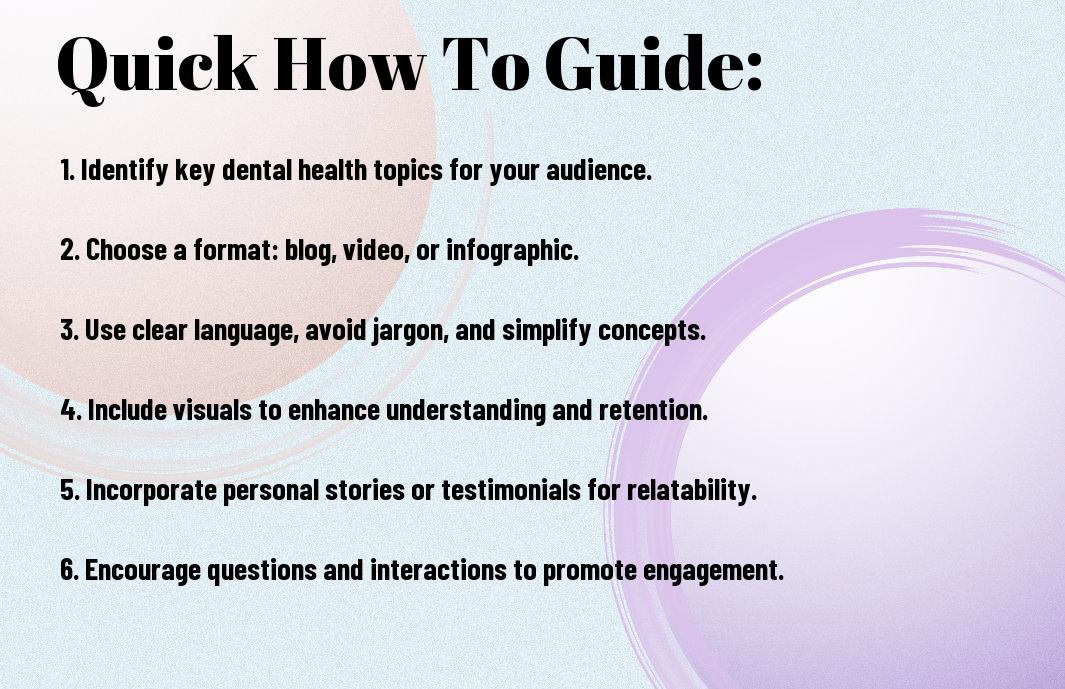How To Create Engaging Content That Educates Patients On Dental Health
You might wonder how to effectively engage your patients while educating them on vital dental health topics. In this post, I will share proven strategies to create compelling content that not only captures attention but also enhances your patients’ understanding of dental practices. By using clear language, visual aids, and interactive elements, you can empower your patients to take charge of their oral health. Let’s examine the techniques that will make your content resonate with your audience and encourage better dental habits!
Key Takeaways:
- Audience Understanding: Tailor content to meet the specific needs and concerns of your patient demographic.
- Visual Appeal: Incorporate graphics, infographics, and videos to make complex dental topics more digestible.
- Simple Language: Use clear and straightforward language to ensure that all patients can understand the information presented.
- Engagement Techniques: Encourage interaction through quizzes, polls, and questions to foster a dialogue about dental health.
- Multi-Platform Sharing: Distribute content across various platforms like social media, blogs, and newsletters to reach a wider audience.
- User-Generated Content: Invite patients to share their dental experiences to create relatable and authentic content.
- Regular Updates: Keep content fresh and relevant by regularly updating information based on the latest dental research and trends.

Understanding Your Audience
Before I can create content that is engaging and informative, I need to take the time to truly understand the audience I’m speaking to. Engaging dental health content must resonate with the specific concerns, questions, and interests of my patients. By getting to know my audience’s demographics, lifestyle choices, and existing knowledge about dental health, I can ensure that the information I provide is both relevant and relatable. This foundational understanding not only helps in crafting content but also makes my communication feel more personal and tailored to each individual’s needs.
Identifying Patient Needs
With this in mind, identifying patient needs becomes a pivotal step. I can do this by gathering feedback through surveys, social media interactions, or even casual conversations in my practice. Understanding the common questions patients ask, the misconceptions they have, and the stumbling blocks they face in maintaining their dental hygiene allows me to focus my content creation around these themes. When I address specific needs, I make sure my content provides clear, actionable insights that foster a sense of empowerment and responsibility in my readers.
Tailoring Content Appropriately
To engage my audience effectively, I must tailor my content to align with their preferences and comprehension levels. This means using language that is clear and straightforward, avoiding jargon that may alienate or confuse them. Additionally, I strive to incorporate various formats—like videos, infographics, and podcasts—because I know different people absorb information in different ways. By mixing up the types of content I create, I can keep my audience interested while ensuring that they are absorbing vital dental health information.
Patient engagement thrives when I consider their unique characteristics and preferences. By producing high-quality, relevant content that addresses their concerns, I encourage readers to interact with the material and even share it with others. This can foster a community of informed individuals who feel empowered to take charge of their oral health. Most importantly, I ensure that the tone is always supportive and informative, showing patients that I am here to guide them towards healthier habits and understanding.

Choosing the Right Formats
There’s a wide array of content formats available to engage your audience effectively. When opting for the right format for educating patients on dental health, consider where your audience is most active and receptive. For dentists, platforms like social media present an incredible opportunity to reach patients with informative content that resonates with them. To explore this further, I recommend checking out this insightful article on Social Media Marketing for Dentists: Benefits, Strategy, and …. Finding the right approach not only enhances engagement but also ensures that your messages are clearly communicated and easily digestible for everyone.
Infographics and Visuals
Right from the start, I find that visuals, especially infographics, are a powerful way to convey complex dental health information. Infographics can simplify intricate topics, making them more accessible and enjoyable for your patients. By incorporating eye-catching graphics and clear statistics, you can foster a better understanding of dental procedures or oral hygiene practices, thus equipping your patients with the knowledge they need to make informed decisions about their health. Engaging visuals not only attract attention but also facilitate retention, meaning your audience is likely to remember your message long after they’ve seen it.
Videos and Podcasts
On the other hand, incorporating video and audio formats can significantly enhance your outreach. Videos allow you to demonstrate procedures, provide tips, and share patient testimonials in a dynamic way that text alone cannot achieve. Alongside videos, podcasts give you the opportunity to engage with your audience on the go, discussing various dental topics in depth while your patients commute or carry out daily tasks. This dual approach ensures that you cater to different preferences, allowing you to reach a broader audience.
Understanding the *benefits of video and podcast formats can profoundly impact your content strategy*. By using videos, you can showcase practical demonstrations that may alleviate patient anxieties, making certain procedures seem less daunting. Podcasts allow for deeper conversations and explorations into various dental health topics. The combination of both formats caters to visual and auditory learners, maximizing the potential for engagement. It’s vital to focus on creating quality content that speaks to your audience’s needs, balancing *educational value* with *entertainment* for the best results.
Crafting Clear and Concise Messages
Your ability to create clear and concise messages is vital when educating patients on dental health. This not only helps in conveying important information effectively, but it also ensures that patients feel confident in their understanding of the material. By breaking down complex subjects into digestible pieces, you can create a more engaging experience that encourages patients to act on what they learn about maintaining their dental health. Always aim for simplicity, clarity, and relevance in your content to create a strong connection with your audience.
Simplifying Complex Terminology
You may find that the field of dentistry is filled with complex terminology that can confuse patients. To enhance their understanding, try to simplify these terms when possible. For instance, instead of saying “periodontal disease,” you might explain it as “gum disease.” This way, patients can relate to the topic more personally, as it removes the barrier of unfamiliar jargon. Utilizing analogies, visual aids, and relatable examples can go a long way in making dental concepts accessible and engaging for everyone.
The Importance of Tone and Voice
Simplifying the language we use is important, but equally significant is the tone and voice we adopt in our messaging. A friendly and approachable tone can create a sense of comfort and trust between you and your patients. When I choose a tone that is supportive and encouraging, it fosters an environment where patients feel empowered to ask questions and seek clarification. This connection can enhance their learning experience, helping them to absorb the information more effectively. By striking the right balance between professionalism and approachability, we can establish credibility while making dental health topics more inviting.
Complex topics related to dental health can sometimes seem daunting or intimidating, but engaging patients through a positive tone can help dissolve these feelings. When I incorporate a warm and welcoming voice into my content, it not only conveys my expertise but also emphasizes my dedication to their well-being. I strive to make the learning process enjoyable and informative, and this correlation between tone and engagement is pivotal in motivating patients to prioritize their dental health.
Incorporating Educational Strategies
Unlike traditional methods that merely present facts and figures, I find that incorporating educational strategies can transform the way patients engage with dental health content. Using a variety of techniques not only enhances understanding but also builds a genuine connection with your audience. When crafting your message, consider what educational strategies resonate most with your target demographic, whether that’s utilizing infographics, videos, or interactive elements that make the learning process more engaging and memorable.
Storytelling Techniques
Some of the most compelling content I create stems from the use of storytelling techniques. By weaving personal anecdotes, relatable scenarios, and case studies into your educational material, you can captivate your audience’s attention and impart valuable lessons in a more palatable manner. For instance, sharing a patient’s journey of overcoming dental anxiety can accompany facts about stress management techniques, making the content not just informative but also emotionally relatable.
Interactive Content Ideas
Educational strategies can be further enhanced through the use of interactive content ideas, which I find immensely effective for patient engagement. Incorporating quizzes, polls, and interactive infographics allows patients to actively participate in their learning journey. As your audience engages with these elements, they start to internalize the information more effectively, leading to deeper understanding and retention.
Interactive content is not just an entertaining way to share dental health tips; it serves as a powerful tool to boost engagement and promote retention of crucial information. By allowing patients to assess their own dental habits through interactive quizzes or experience scenarios through decision-making activities, you can encourage them to think critically about their dental health. This active involvement not only educates but also empowers them to make better decisions regarding their oral care, fostering a sense of responsibility and self-efficacy.
Utilizing Digital Platforms
Once again, it’s crucial to leverage the power of digital platforms to share information on dental health effectively. Digital platforms open up numerous avenues for providing patients with engaging and educational content. By creating a strong online presence, you can ensure that your messages reach a broader audience. Utilizing what the digital world has to offer can enhance your ability to educate your patients while establishing your authority in the field of dentistry.
Social Media Engagement
There’s no denying that social media has become a powerful tool for engagement. By using platforms like Facebook, Instagram, or Twitter, I can connect with patients on a more personal level. Sharing valuable tips, interesting facts, and even patient testimonials can drive meaningful conversations about dental health. I encourage you to use visually appealing content, including images and videos, which help demystify dental procedures and encourage patients to take an active interest in their oral health.
Website Optimization for SEO
Even if social media is critical for instant engagement, I must not underestimate the importance of having a well-optimized website for search engines. SEO (Search Engine Optimization) plays a significant role in ensuring that patients can find my practice easily when they search for dental-related topics. By implementing relevant keywords, creating informative blogs, and enhancing site speed, I can improve my website’s visibility and provide a better user experience.
Another aspect of website optimization is ensuring mobile-friendliness. As patients increasingly use their smartphones to access information, I need to ensure that my website is responsive and loads quickly on all devices. Additionally, including strong calls to action and easy navigation can significantly enhance user experience. By focusing on these elements, I can not only enhance my site’s SEO performance but also make it a valuable resource that encourages patients to prioritize their dental health.

Measuring Engagement and Feedback
Now that I’ve discussed the importance of creating engaging content, I must emphasize the significance of measuring that engagement and gathering feedback. To truly understand how well your content resonates with patients, you need to employ various analytics tools. These tools can help you track metrics such as page views, time spent on each page, and social media interactions. By analyzing this data, you can pinpoint which topics resonate most with your audience and refine your content strategy moving forward. For a comprehensive guide on how to effectively combine Dental Content Marketing & SEO: Create a Strategy in 7 …, I suggest you explore detailed insights that can enhance your engagement efforts.
Tools for Analytics
With multiple analytics tools available today, it can be overwhelming to choose the right one for your dental practice. I personally recommend tools like Google Analytics for web traffic insights and social media analytics for gauging your audience’s behavior on various platforms. These tools provide valuable data that can help you determine which content types—be it informational articles, videos, or infographics—are most effective in educating your patients. Utilizing a combination of these tools can give you a well-rounded view of your content’s performance and engagement levels.
Adapting Based on Feedback
An vital part of refining your content strategy lies in adapting based on the feedback you receive. Whether it’s constructive criticism from patients or insights drawn from analytics, being open to change is key. I encourage you to solicit feedback through polls or surveys directly on your platform. This proactive approach allows you to align your content more closely with your audience’s needs and preferences.
Plus, by continuously gathering and analyzing feedback, you can create a loop that not only enhances your content but also increases patient satisfaction. For instance, if you notice that certain topics are receiving significant engagement while others are falling flat, you can focus your future content creation on those popular subjects. This iterative process will not only improve your content effectiveness but also establish your practice as a trusted and responsive authority on dental health. Ultimately, this engagement can lead to stronger patient relationships and a more informed community.
Final Words
Hence, by implementing the strategies discussed, I believe we can create engaging content that not only captures your interest but also informs you about vital dental health topics. It’s necessary to focus on clarity and relatability, ensuring that your audience feels connected and informed. Providing resources, such as articles or guides, can enhance their understanding and foster a supportive community where your patients feel encouraged to ask questions. You might find resources like The Art of Effective Patient Education in Dentistry particularly beneficial in shaping your approach.
Conclusively, educating patients about dental health is a rewarding journey that requires creativity and empathy. I encourage you to be proactive in sharing relevant information, utilizing various formats such as videos, blogs, and interactive quizzes to maintain engagement. Ultimately, your efforts will contribute to healthier smiles and empowered patients who value their oral health. By continuing to adapt and innovate your content, you can ensure that your approach remains effective and enriching for everyone involved.
FAQ
Q: Why is it important to create engaging content for patients about dental health?
A: Engaging content helps to inform and educate patients about dental health, fostering a better understanding of oral hygiene practices. When patients are well-informed, they are more likely to take proactive steps in maintaining their dental health, leading to better outcomes and decreased anxiety regarding dental visits.
Q: What types of content can I create to educate patients effectively?
A: You can create a variety of content types such as blog posts, infographics, videos, podcasts, and social media posts. Each format can cater to different learning styles, ensuring that you reach a broader audience effectively. Incorporating real-life patient stories can also add a relatable element to your content.
Q: How can I make dental content relatable to patients?
A: Use everyday language and avoid medical jargon, which can confuse patients. Share common dental experiences and concerns that patients can relate to, and include tips that are practical and easy to implement. Adding visuals, such as images or videos, demonstrating techniques like proper brushing can also enhance relatability.
Q: What platforms should I use to distribute my dental health content?
A: Utilize multiple platforms to maximize reach. Your dental practice website, social media channels (such as Facebook, Instagram, and Twitter), email newsletters, and even community workshops are excellent venues for sharing your content. Tailoring your approach to suit each platform can enhance engagement and visibility.
Q: How can I measure the effectiveness of my content in educating patients?
A: Track engagement metrics such as likes, shares, comments, and website traffic to assess how your content resonates with your audience. Additionally, consider conducting surveys or polls to collect feedback from patients regarding what they found helpful or what they would like to learn more about.
Q: How often should I update my dental health content?
A: Regular updates are important to keep your content relevant. Aim to refresh your content at least every few months or whenever new dental research or guidelines emerge. Seasonal topics, like back-to-school dental checkups or holiday sugar guidelines, can provide timely and engaging content opportunities.
Q: What is the role of SEO in creating engaging dental content?
A: Implementing SEO strategies is key to making your content easily discoverable online. Use keywords related to dental health that patients are likely to search for. Write compelling meta descriptions and utilize headings properly to improve search rankings, ultimately reaching more patients with your educational content.






